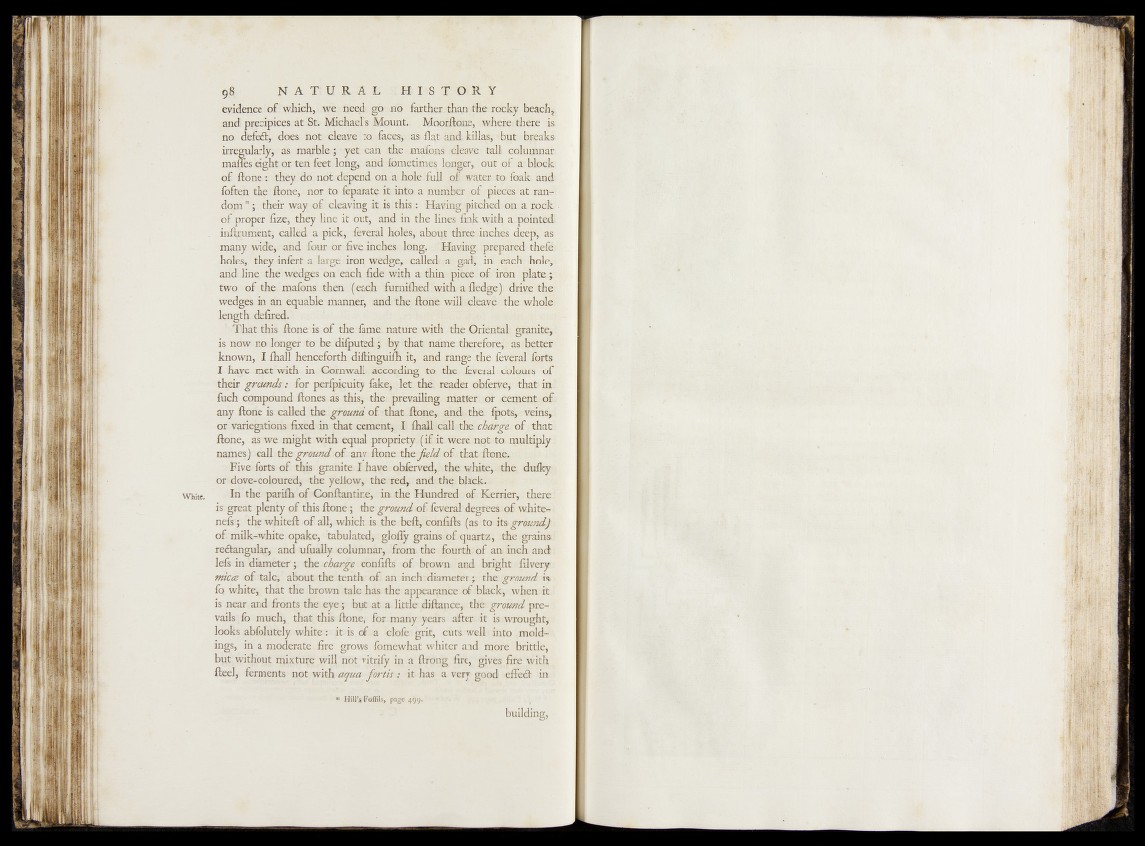
$$ N A T U R A L K I ’S T O R Y
evidence of f which, we need go:®© fartherthap the» /rofci^r heach?
and« pifcipices. at Michael’s Mount. Moodfone, whesijltfieitfe is
no. ctefedt; does not ckaKelta faces, asvil^t and kiUa^s, -bqt hteaks-
irregularly, as marble; yet can the melons cleave tall columnar
maffes eight or ten feet long, and fometimes longer, out of a block
of ftone : they do not depend on a hole full of water to. foak and
foftqn the ftone, nor to feparate it into a number of pieces at random
” ; their way of cleaving it is this: Having pitched on a rock
of proper fize, they line it out, and in the lines fink with.a pointed:
. inftrument, called a pick, {Several holes, about three inches deep, as
many wide, and four or. five inches long. . Having, prepared thefe.
holes, they infert a large iron wedge, called a gad, in each hole,
add line the wedges on each fide with a thin piece of. iron plate;
two of the mafons then (each furniflied with a fledge) drive the
wedges in an equable manner, and the ftone will cleave the whole
length defired.
That this ftone is of the lame, nature with the Oriental; granite;
is now. no longer to be difputed ; by that name, therefore;.’ as.better
known, I fhall henceforth diftinguim it, and range the- fevmaTforts
I haye met with in Cornwall according to the. feveral: colcsurs oF
their grounds : for perfpicuity fake, let the. reader abferve, that1 ini
filch compound ftones as this, the prevailing matter or cemenj^ofc
any ftone is called the ground of that, ftone, and. the fpofcs, veins,
or variegations fixed in that cement, I {hall .calktharAdffg'a o f ; that:
ftone, asrwe might with equal propriety. (Miit: Were noftto multiply
names) call the ground of; any; ftone theyj&iflkof. that'fton^
Bive forts o f this granite l have observed, the whke,. , the dufky
or dove-coloured, the yellow, the red, and the. black.
White. In the parifti of Conftantine, in the Hundred of Kenier, there
is great plenty o f this ftone j the ground ofifeveraL degrees. o£ whiter
nefe; the whiteft o f all, which is the befl^confifts (as to \t&ground)
of.:milk-white opake, tabulated,, glofly grains, of quartz, the grains
redtangukr, and ufually columnar, from, the fourth of an inch and
lels in diameter’; the char-go confifts of brown, and bright filvery
micce of- talc, about the tenth o f an inch, diameter ; the. ground is
fo white, that the brown talc has. the appearance of black, when it.
is near and fronts the eye; but.-at a.little diftapee, the. ground prevails
fo much, that this ftone, for. many years after it is. wrought,
looks abfolutely white : i t is. o f a cl'ofe. grit, cuts well into moldings,
in a moderate fire grows fomewhat whiter and more brittle,
but without mixture will not. vitrify in .a ftrong. fire, gives fire with
fteel, ferments not. with:aqua f o r t i s it has a very good effedt in.
■ Hiii’j Foffils, page 499.' ■
building,